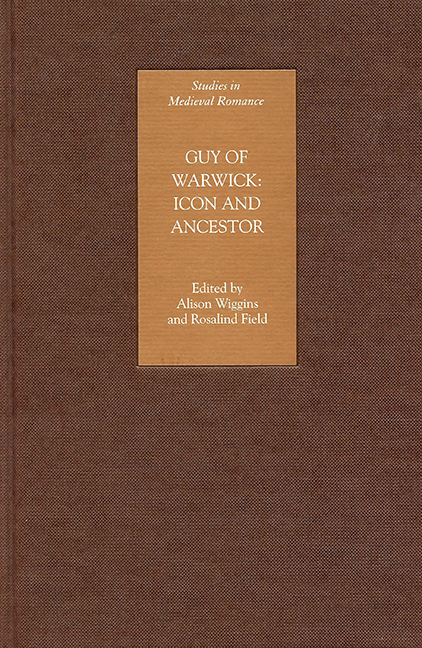Book contents
- Frontmatter
- Contents
- Illustrations
- Contributors
- Abbreviations
- Dedication
- Editorial Introduction: Namoore of this! How to read Guy of Warwick and why
- 1 Gui de Warewic at Home and Abroad: A Hero for Europe
- 2 Gui de Warewic in its Manuscript Context
- 3 Guy of Warwick as a Translation
- 4 From Gui to Guy: The Fashioning of a Popular Romance
- 5 The Manuscripts and Texts of the Middle English Guy of Warwick
- 6 The Speculum Guy de Warwick and Lydgate's Guy of Warwick: The Non-Romance Middle English Tradition
- 7 An Exemplary Life: Guy of Warwick as Medieval Culture-Hero
- 8 The Visual History of Guy of Warwick
- 9 ‘In her owne persone semly and bewteus’: Representing Women in Stories of Guy of Warwick
- 10 Of Dragons and Saracens: Guy and Bevis in Early Print Illustration
- 11 Guy of Warwick and The Faerie Queene, Book II: Chivalry Through the Ages
- 12 Guy as Early Modern English Hero
- Appendix: Synopsis of the Guy of Warwick narrative
- Index
8 - The Visual History of Guy of Warwick
Published online by Cambridge University Press: 24 October 2017
- Frontmatter
- Contents
- Illustrations
- Contributors
- Abbreviations
- Dedication
- Editorial Introduction: Namoore of this! How to read Guy of Warwick and why
- 1 Gui de Warewic at Home and Abroad: A Hero for Europe
- 2 Gui de Warewic in its Manuscript Context
- 3 Guy of Warwick as a Translation
- 4 From Gui to Guy: The Fashioning of a Popular Romance
- 5 The Manuscripts and Texts of the Middle English Guy of Warwick
- 6 The Speculum Guy de Warwick and Lydgate's Guy of Warwick: The Non-Romance Middle English Tradition
- 7 An Exemplary Life: Guy of Warwick as Medieval Culture-Hero
- 8 The Visual History of Guy of Warwick
- 9 ‘In her owne persone semly and bewteus’: Representing Women in Stories of Guy of Warwick
- 10 Of Dragons and Saracens: Guy and Bevis in Early Print Illustration
- 11 Guy of Warwick and The Faerie Queene, Book II: Chivalry Through the Ages
- 12 Guy as Early Modern English Hero
- Appendix: Synopsis of the Guy of Warwick narrative
- Index
Summary
King Arthur's only serious rival for the affections of the late medieval public was the legendary English hero Guy of Warwick. Guy's fame is the result of a combination of factors but, as with Arthur, it is rooted in an intersection of history and romance that raises him above mere chivalric exemplar to the status of national hero. This iconic role manifests itself in a diverse textual culture from the thirteenth century that spans fictional and historiographic works. These texts in turn generate a substantial visual and material legacy that complements the literary versions and which must have appealed to the same kinds of audiences. Such a diverse collection of objects is a testimony to the power and influence of textual activity over an extended period of time, and to the ways in which Guy, like Arthur, inhabited a central place in the nation's cultural heritage. Images and artefacts underline the ways in which Guy functions as a model of martial prowess and spiritual growth but, further, they reveal how his legend contributes to the formation of familial, civic, and political identities in the late medieval period.
Guy's position as acknowledged English hero is demonstrated by the appearance of episodes from his career in a number of mid-fourteenth-century English manuscripts. To judge from these surviving examples Guy found relatively early pictorial form in a variety of linguistic and generic contexts. Of these the most technically proficient, and probably the earliest, appears in a copy of Peter Langtoft's French verse Chronique d'Angleterre produced between 1307 and 1327 (British Library, MS Royal 20. A. II). As a history of the English peoples Langtoft's work hardly emerges from the shadows of its authorities – Bede, Geoffrey of Monmouth, Wace, and others – though it does provide an important contemporary witness of most of the reign of Edward I. This range and topicality accounts for its general popularity, and for its use in the late 1330s as a primary source for Robert Mannyng's English chronicle Brut.
- Type
- Chapter
- Information
- Guy of Warwick: Icon and Ancestor , pp. 110 - 132Publisher: Boydell & BrewerPrint publication year: 2007

